SNVS215D April 2003 – November 2015 LM5030
PRODUCTION DATA.
- 1 Features
- 2 Applications
- 3 Description
- 4 Revision History
- 5 Pin Configuration and Functions
- 6 Specifications
- 7 Detailed Description
- 8 Application and Implementation
- 9 Power Supply Recommendations
- 10Layout
- 11Device and Documentation Support
- 12Mechanical, Packaging, and Orderable Information
Package Options
Mechanical Data (Package|Pins)
Thermal pad, mechanical data (Package|Pins)
Orderable Information
6 Specifications
6.1 Absolute Maximum Ratings
over operating free-air temperature range (unless otherwise noted) (1)| MIN | MAX | UNIT | ||
|---|---|---|---|---|
| VIN to GND (Survival) | –0.3 | 100 | V | |
| VCC to GND (Survival) | –0.3 | 16 | V | |
| RT to GND (Survival) | –0.3 | 5.5 | V | |
| All other pins to GND (Survival) | –0.3 | 7 | V | |
| Power dissipation | Internally Limited | |||
| Lead temperature (soldering 4 seconds) | 260 | °C | ||
| Operating junction temperature | 150 | °C | ||
| Storage temperature, Tstg | –55 | 150 | °C | |
(1) Stresses beyond those listed under Absolute Maximum Ratings may cause permanent damage to the device. These are stress ratings only, which do not imply functional operation of the device at these or any other conditions beyond those indicated under Recommended Operating Conditions. Exposure to absolute-maximum-rated conditions for extended periods may affect device reliability.
6.2 ESD Ratings
| VALUE | UNIT | |||
|---|---|---|---|---|
| V(ESD) | Electrostatic discharge | Human body model (HBM), per ANSI/ESDA/JEDEC JS-001(1) | ±2000 | V |
| Machine model (MM) | ±200 | |||
(1) JEDEC document JEP155 states that 500-V HBM allows safe manufacturing with a standard ESD control process.
6.3 Recommended Operating Conditions
over operating free-air temperature range (unless otherwise noted)| MIN | NOM | MAX | UNIT | ||
|---|---|---|---|---|---|
| VIN | 14 | 90 | V | ||
| TJ Operating junction temperature | –40 | 105 | °C | ||
6.4 Thermal Information
| THERMAL METRIC(1) | LM5030 | UNIT | ||
|---|---|---|---|---|
| DGS (VSSOP) | DPR (WSON) | |||
| 10 PINS | 10 PINS | |||
| RθJA | Junction-to-ambient thermal resistance | 158.8 | 38.1 | °C/W |
| RθJC(top) | Junction-to-case (top) thermal resistance | 53.6 | 137.1 | °C/W |
| RθJB | Junction-to-board thermal resistance | 74.8 | 15.2 | °C/W |
| ψJT | Junction-to-top characterization parameter | 5.3 | 0.4 | °C/W |
| ψJB | Junction-to-board characterization parameter | 77.6 | 15.4 | °C/W |
| RθJC(bot) | Junction-to-case (bottom) thermal resistance | — | 4.6 | °C/W |
(1) For more information about traditional and new thermal metrics, see the Semiconductor and IC Package Thermal Metrics application report, SPRA953.
6.5 Electrical Characteristics
Specifications are for TJ = 25°C. Unless otherwise specified: VIN = 48 V, VCC = 10 V, and RT = 26.7 kΩ| PARAMETER | TEST CONDITIONS | MIN(1) | TYP(2) | MAX(1) | UNIT | ||
|---|---|---|---|---|---|---|---|
| START-UP REGULATOR | |||||||
| VCCReg | VCC Regulation | Open ckt | TJ = 25°C | 7.7 | V | ||
| full operating junction temperature range | 7.4 | 8.0 | |||||
| VCC Current limit | See Figure 2 | TJ = 25°C | 17 | mA | |||
| full operating junction temperature range | 10 | ||||||
| I-VIN | Start-up regulator leakage (external VCC supply) | VIN = 90 V | TJ = 25°C | 150 | µA | ||
| full operating junction temperature range | 500 | ||||||
| IIN | Shutdown current | SS = 0 V, VCC = open | TJ = 25°C | 250 | µA | ||
| full operating junction temperature range | 350 | ||||||
| VCC SUPPLY | |||||||
| VCC Undervoltage lockout voltage | TJ = 25°C | VCCReg – 100 mV | V | ||||
| full operating junction temperature range | VCCReg – 300 mV | ||||||
| Undervoltage hysteresis | TJ = 25°C | 1.6 | V | ||||
| full operating junction temperature range | 1.2 | 2.1 | |||||
| ICC | Supply current | Cload = 0 | TJ = 25°C | 2 | mA | ||
| full operating junction temperature range | 3 | ||||||
| ERROR AMPLIFIER | |||||||
| GBW | Gain bandwidth | 4 | MHz | ||||
| DC gain | 75 | dB | |||||
| Input voltage | VFB = COMP | TJ = 25°C | 1.245 | V | |||
| full operating junction temperature range | 1.220 | 1.270 | |||||
| COMP sink capability | VFB = 1.5 V COMP = 1 V | TJ = 25°C | 13 | mA | |||
| full operating junction temperature range | 5 | ||||||
| CURRENT LIMIT | |||||||
| CS1 | Cycle-by-cyble CS threshold voltage | TJ = 25°C | 0.5 | V | |||
| full operating junction temperature range | 0.45 | 0.55 | |||||
| CS2 | Restart CS threshold voltage | Resets SS capacitor; auto restart | TJ = 25°C | 0.625 | V | ||
| full operating junction temperature range | 0.575 | 0.675 | |||||
| ILIM delay to output | CS step from 0-V to 0.6-V time-to-onset of OUT transition (90%) Cload = 0 |
30 | ns | ||||
| CS sink current (clocked) | CS = 0.3 V | TJ = 25°C | 6 | mA | |||
| full operating junction temperature range | 3 | ||||||
| SOFT START AND SHUTDOWN | |||||||
| Softstart current source | TJ = 25°C | 10 | µA | ||||
| full operating junction temperature range | 7 | 13 | |||||
| Softstart to COMP offset | TJ = 25°C | 0.5 | V | ||||
| full operating junction temperature range | 0.25 | 0.75 | |||||
| Shutdown threshold | TJ = 25°C | 0.45 | V | ||||
| full operating junction temperature range | 0.2 | 0.7 | |||||
| OSCILLATOR | |||||||
| Frequency1 (RT = 26.7K) | TJ = 25°C | 200 | kHz | ||||
| full operating junction temperature range | 175 | 225 | |||||
| Frequency2 (RT = 8.2K) | TJ = 25°C | 600 | kHz | ||||
| full operating junction temperature range | 510 | 690 | |||||
| Sync threshold | TJ = 25°C | 3.2 | V | ||||
| full operating junction temperature range | 3.8 | ||||||
| PWM COMPARATOR | |||||||
| Delay to output | COMP set to 2-V CS stepped 0 to 0.4 V, time-to-onset of OUT transition low | 30 | ns | ||||
| Max duty cycle | Inferred from deadtime | TJ = 25°C | 49% | ||||
| full operating junction temperature range | 47.5% | 50% | |||||
| Min duty cycle | COMP = 0 V | full operating junction temperature range | 0% | ||||
| COMP to PWM comparator gain | 0.34 | V / V | |||||
| COMP open circuit voltage | VFB = 0 V | TJ = 25°C | 5.2 | V | |||
| full operating junction temperature range | 4.3 | 6.1 | |||||
| COMP short circuit current | VFB = 0 V, COMP = 0 V | TJ = 25°C | 1.1 | mA | |||
| full operating junction temperature range | 0.6 | 1.5 | |||||
| SLOPE COMPENSATION | |||||||
| Slope comp amplitude | Delta increase at PWM Comparator to CS | TJ = 25°C | 105 | mV | |||
| full operating junction temperature range | 80 | 130 | |||||
| OUTPUT SECTION | |||||||
| Deadtime | Cload = 0, 10% to 10% | TJ = 25°C | 135 | ns | |||
| full operating junction temperature range | 85 | 185 | |||||
| Output high saturation | Iout = 50 mA, VCC – VOUT | TJ = 25°C | 0.25 | V | |||
| full operating junction temperature range | 0.75 | ||||||
| Output low saturation | IOUT = 100 mA | TJ = 25°C | 0.25 | V | |||
| full operating junction temperature range | 0.75 | ||||||
| Rise time | Cload = 1 nF | 16 | ns | ||||
| Fall time | Cload = 1 nF | 16 | ns | ||||
| THERMAL SHUTDOWN | |||||||
| Tsd | Thermal shutdown temperature | 165 | °C | ||||
| Thermal shutdown hysteresis | 15 | °C | |||||
(1) Limits are 100% production tested at 25°C. Limits over the operating temperature range are specified through correlation using Statistical Quality Control (SQC) methods. The limits are used to calculate TI's Average Outgoing Quality Level (AOQL).
(2) Typical numbers represent the most likely parametric norm for 25°C operation.
6.6 Typical Characteristics
at TJ = 25°C (unless otherwise noted)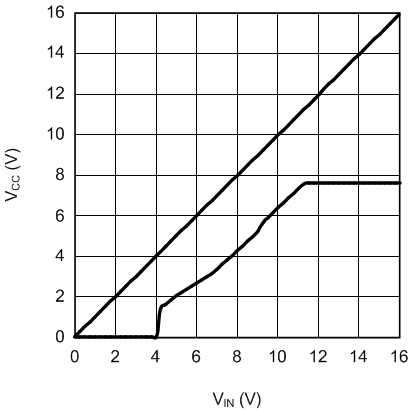 Figure 1. VCC vs VIN
Figure 1. VCC vs VIN
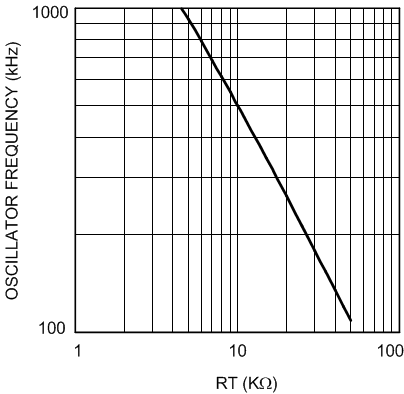 Figure 3. Oscillator Frequency vs RT
Figure 3. Oscillator Frequency vs RT
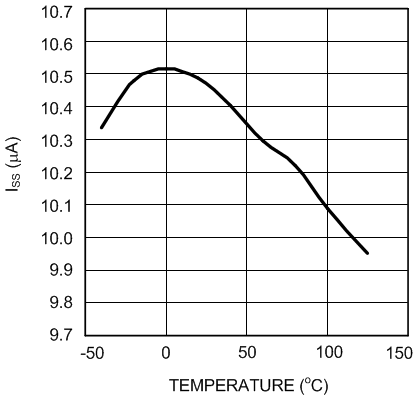 Figure 5. Softstart Current vs Temperature
Figure 5. Softstart Current vs Temperature
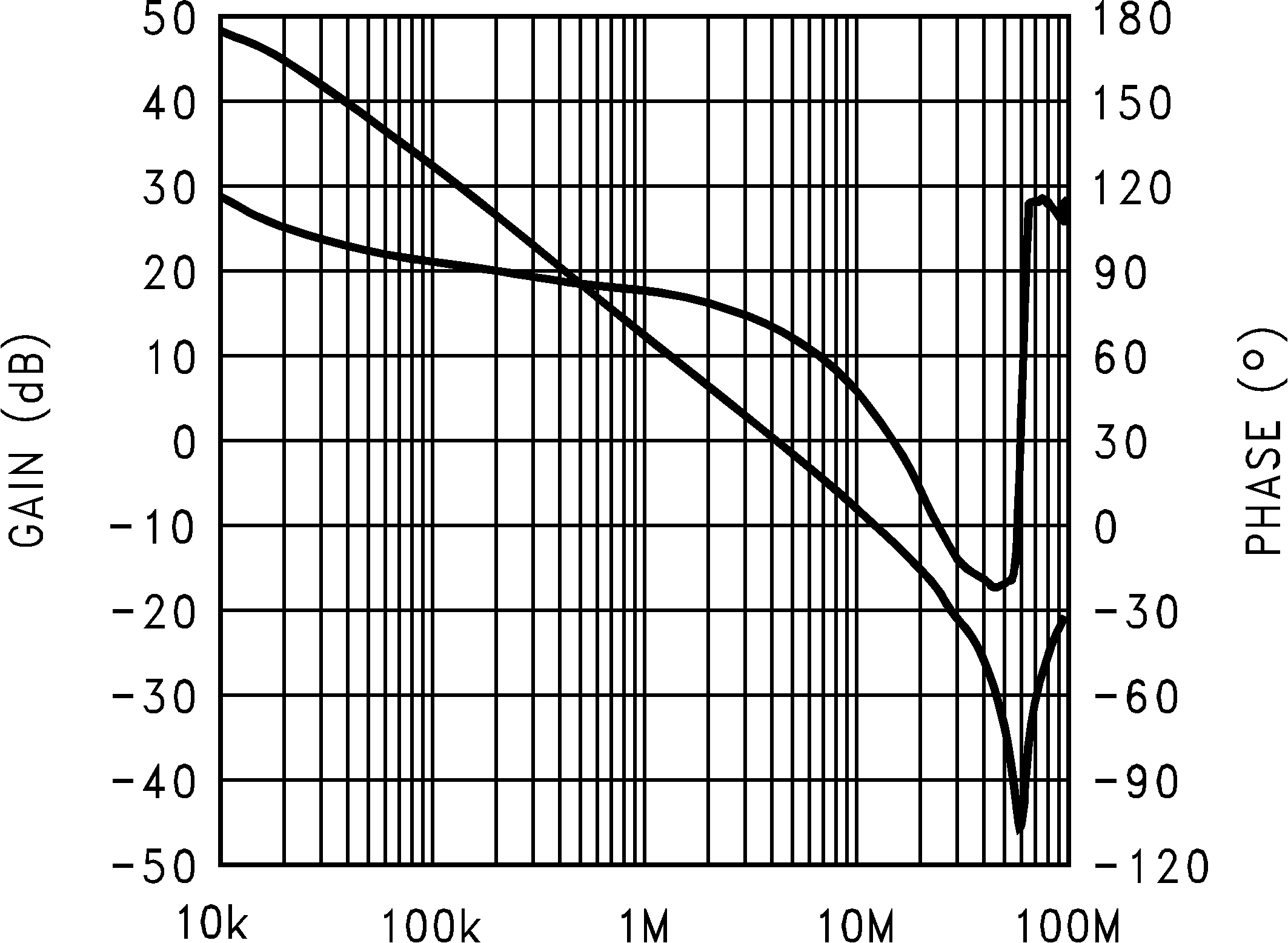 Figure 7. Feedback Amplifier Gainphase
Figure 7. Feedback Amplifier Gainphase
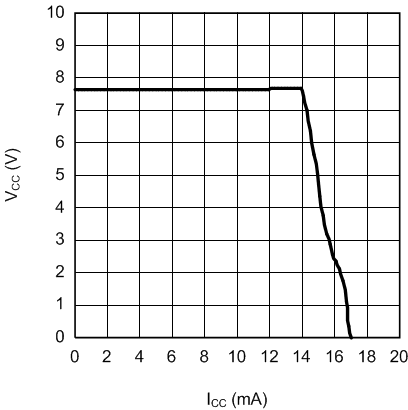 Figure 2. VCC vs ICC (VIN = 48 V)
Figure 2. VCC vs ICC (VIN = 48 V)
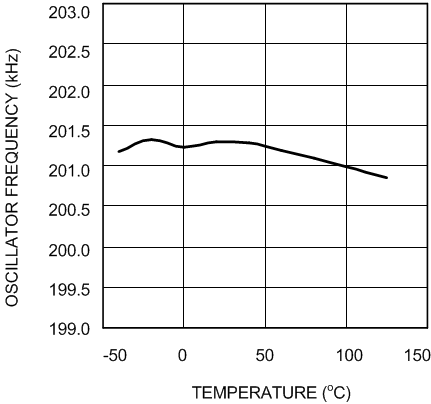 Figure 4. Oscillator Frequency vs Temperature RT = 26.7 kΩ
Figure 4. Oscillator Frequency vs Temperature RT = 26.7 kΩ
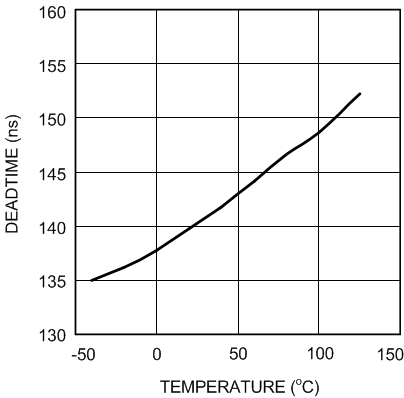 Figure 6. Deadtime vs Temperature
Figure 6. Deadtime vs Temperature